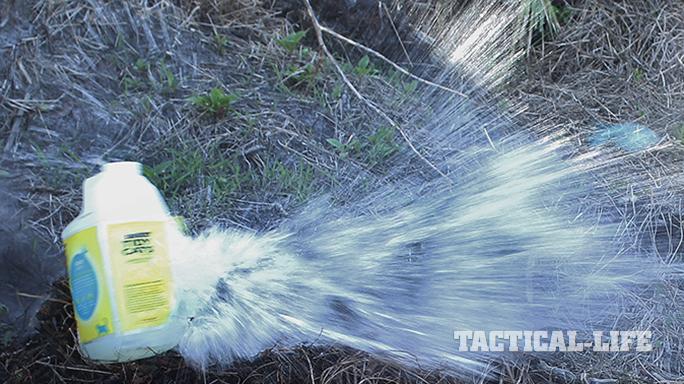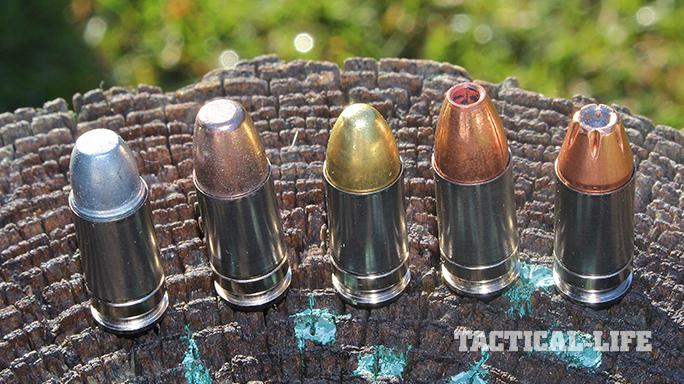Ammunition is probably the fastest-changing portion of the shooting sports industry. We’re constantly being introduced to new cartridges, bullets, powders and even primers. But it’s been decades since the introduction of aluminum and steel cartridge cases. There have been recent experiments with using polymer to replace brass, but up until the recent appearance of the NAS3 9mm shell case from Shell Shock Technologies of Westport, Connecticut, there was no real alternative to the one-piece brass, aluminum and steel centerfire rifle and pistol cases we’ve all used for years. But all of that is about to change.
NAS3 Design

Shell Shock’s NAS3 case is a two-piece design that is made of steel and aluminum. Other cases use steel or aluminum, but the Shell Shock case is not made of just any steel and aluminum. The steel is a high-tensile nickel-steel alloy, and the aluminum is an aircraft-quality alloy with electroless nickel plating.
The concept of a two-piece cartridge case isn’t new. The earliest two-piece case I could find was the .442 blackpowder revolver cartridge made for the Tranter revolver in England during the late 1860s. Today, almost all shotgun shells are of two-piece construction. Most of the two-piece designs, including shotshells, were originally designed for low-pressure blackpowder cartridges. On the other hand, the NAS3 case is designed for high pressure. It has a cylindrical steel body and an aluminum head, which are held together by a compression joint that becomes stronger as the pressure increases, forcing the two pieces of the case together. Because of this and the fact that the case walls are steel, the Shell Shock 9mm case is claimed to be able to tolerate pressures up to 70,000 psi, which provides a wide margin of safety given that the SAAMI maximum average for a +P 9mm is 38,500 psi.
Advertisement — Continue Reading Below
Because of their rather unique design and materials, the Shell Shock cases work differently than conventional solid-brass cases. When fired, cases made of brass expand to fill the chamber to prevent gas leaks, and they generally keep their expanded shape long after the bullet has left the barrel. The steel cylinders of the Shell Shock cases also expand, but they snap back quickly and remain close to their original size. Evidently, the case does not snap back until the projectile has left the bore. This prevents gas leaks and also helps keep cartridge backpressure on the breech face from reaching levels that would damage the pistol. In addition, the case’s two-piece construction gives it slightly more internal volume than traditional brass 9mm cases. The Shell Shock case also has a more uniform and slightly larger flash hole, and its manufacturer claims that because of this it has more uniform ignition and less shot-to-shot variation in velocity.
Normally, one might expect that a shell case with all of these features would cost more than a traditional brass case. It doesn’t. As of this writing, 1,000 new, unprimed NAS3 cases cost $100 when purchased online from the manufacturer. Commercial brass costs anywhere from $160 to $194 online. Shell Shock also states that these cases can be reloaded as much as 32 times. A special set of resizing and flaring dies is required. A set costs $100 and requires that the cases be lubricated even though the sizing die has a carbide insert. The dies work with a variety of commercial presses. Since this is a two-piece case, these special dies are spring-loaded so that they push the shell out rather than use the shell holder to pull the case out of the die by its rim. This would damage the joint between the case’s cylinder and head. At present, there are no reloading manuals that publish specific data for Shell Shock cases, so one should seek published information from reputable industry sources before assembling handloads.
Shocking & Glocking

As many as 10 manufacturers are offering 9mm ammunition assembled with Shell Shock NAS3 cases. Many of these are relatively new companies that came on the scene in the last few years. I acquired five samples for testing: Creedmoor Ammunition’s 124-grain XTP +P hollow points (HPs), L-Tech’s 124-grain Full Stop copper HPs, Fallout Ammunition’s 115-grain FMJs, Velocity Munition’s 90-grain Z-Shock rounds and ICC’s 100-grain frangible flat-point ammo.
Advertisement — Continue Reading Below
At the Big 3 East Training Center near Daytona Beach, Florida, I tested each load for accuracy and velocity along with reliability. In addition, I fired the ICC load and the two HP loads into ballistic gel to test for penetration and expansion. I also used the ICC and Velocity Munitions loads to shoot rapidly at steel targets to test how well the gun and ammo handled together.
Because the Glock 43 is a sub-compact pistol designed for close range, I tested the ammunition’s accuracy using a two-hand isosceles stance at 7 yards with a silhouette target depicting two assailants, one standing behind the other. The front assailant had a 10-point circle in the chest area and both had 10-point triangles on their heads. I fired three 5-shot strings with each load at separate targets. The maximum possible score for each load was 150 points with fifteen 10-zone hits. I achieved the highest score—140 points with thirteen 10-zone hits—with both the Fallout and L-Tech loads. The lowest score, 115 points with eight 10-zone hits, came with the ICC ammo. No shots from any of the loads landed outside of vital areas. Clearly, ammunition loaded in Shell Shock cases is more than accurate enough for personal defense in even the smallest 9mms at 7 yards.
RELATED STORY: 9mm or 45 ACP? How the Age-Old Debate Should Really Be Approached
Advertisement — Continue Reading Below
The G43 pistol produced about 100- to 150-fps less velocity than factory advertised rates. Given the gun’s short barrel, that’s reasonable performance. The most powerful load was Velocity Munitions’ 90-grain Z-Shock, which produced an average muzzle velocity of 1,368 fps and 394 foot-pounds of muzzle energy. The L-Tech ammo was the mildest load at 948 fps and 247 foot-pounds of energy.
Reliability and handling tests were conducted by shooting mixed loads in the same magazine and by engaging a full-sized steel silhouette with over 100 rounds of rapid fire at 15 yards. The rapid-fire portion of the test started with the pistol at a high-ready retention position. The pistol was then thrust forward into an isosceles stance and fired as rapidly as the front sight could be reacquired on target. The pistol was flawlessly reliable with all of the loads except for the Velocity Munitions load. These bullets have stepped ogives, and the gun failed to fully extract two fired cases during a 100-round test. Evidently the head of the fired case hung up on the step in the ogive of the top round in the magazine. The extractor then slipped off of the fired case, which remained in the chamber, causing a stoppage.
In the next test, I tested the three loads from Creedmoor, L-Tech and ICC by firing them into ballistic gel. The Hornady XTP bullet in the Creedmoor load expanded rapidly to 0.6 inches and penetrated between 13 to 14 inches before it bounced back and settled at a depth of 12 inches. The L-Tech bullet also expanded rapidly, but given that the bullet has three petals that intersect at 120-degree angles, it was rather difficult to take a meaningful measurement of expansion. The best I could estimate with my calipers was about 0.66 inches. This bullet also penetrated between 11 and 11.5 inches. By cutting into the gel block, I was able to determine that the L-Tech’s permanent wound channel was between 0.5 and 0.75 inches wide and had a marked spiral appearance as the blades slowly twisted through the block. The material inside the channel had a shredded appearance, indicating that this bullet both crushed and cut tissue as the blades turned. Both bullets did not lose any weight, and the fired projectiles each weighed 125 grains. In contrast, the ICC frangible bullet went in about 8 inches and completely disintegrated.
Advertisement — Continue Reading Below
Making The Grade

Finally, it needs to be said that while the Shell Shock cases were nearly 100-percent reliable in my Glock 43, these cases are a very recent development and have a unique design. Therefore, it is possible that there could be a lack of compatibility between some specific loads using Shell Shock cases and a limited number of 9mm guns on the market today. Both Shell Shock Technologies and at least two of the ammunition companies who load 9mm ammunition in Shell Shock cases have conducted reliability tests using a broad variety of 9mm firearms with excellent results. Even so, whenever trying a new type of ammo, it’s always best to buy a small amount first and try it out in the gun for which it is intended to assure reliability and accuracy. This goes for brass-cased ammo as well as ammo that uses Shell Shock cases.
Overall, the ammunition loaded with Shell Shock cases performed very well in the G43. The accuracy at close range was very good, reliability was 100 percent with four of the five test loads, and the gun handled well. What’s next? In the future, Shell Shock Technologies is looking to expand its offering of popular handgun and rifle cases to include the 5.56mm NATO, 7.62mm NATO, .45 ACP and .40 S&W.
Advertisement — Continue Reading Below
For more information about Shell Shock Technologies and its NAS3 cases, visit shellshocktechnologies.com.
This article was originally published in “Combat Handguns” July/August 2017. To order a copy, visit outdoorgroupstore.com.

































